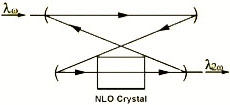NLO conversion
Frequency Conversion
The frequency conversion processes include frequency doubling (which is a special case of sum frequency generation), sum frequency generation (SFG), differential-frequency generation (DFG) and optical parametric generation (OPG) which are demonstrated in the following equations:

Sum Frequency Generation (SFG):
w1 + w2 = w3 (or 1/l1 + 1/l2 = 1/l3 in wavelength) It combines two low-energy (or low- frequency) photons into a high-energy photon. For example:1064 nm + 532 nm -----> 355nm
Sum Frequency Generation
Frequency Doubling
Frequency Doubling or Second Harmonic Generation (SHG) is a special case of sum frequency generation if the two input wavelengths are the same: 2w1 = w2 (or l1 = 2l2 in wavelength). The simplest scheme for frequency doubling is extracavity doubling. The laser passes through the nonlinear crystal only once as shown. However, if the power density of laser is low, focused beam, intracavity doubling and external resonant cavity are normally used to increase the power density on the crystals, for example, for doubling of cw Nd:YAG laser and Argon Ion lasers. If you meet any problems in scheme selection, please contact SUWTECH for a solution
|
|
|
|
Extracavity SHG |
SHG With Focused Beam |
|
|
|
|
Intracavity SHG |
External Resonant cavity SHG |
Frequency Tripling
Frequency Tripling or Third Harmonic Generation (THG) is an other example of Sum Frequency Generation where, for THG of Nd:YAG laser, l1=1064nm, l2=532nm and generated wavelength l3=355nm. By sum frequency of fundamental wavelength and THG of a Ti:Sapphire laser in BBO crystal, it can generate wavelength as short as 193nm.
Differential-Frequency Generation (DFG):
wp = ws + wi (or 1/lp = 1/ls + 1/li in wavelength) It splits one high-energy photon into two low-energy photons. For example:355 nm ---->532 nm + 1064 nm

Differential Frequency Generation
Optical Parametric Generation (OPG):
wp = ws + wi (or 1/lp = 1/ls + 1/li in wavelength) It splits one high-energy photon into two low-energy photons. For example:355 nm ---->532 nm + 1064 nm

Optical Parametric Generation (OPG) is an inverse process of Sum Frequency Generation. It splits one high-frequency photon (pumping wavelength, lp) into two low-frequency photons (signal, ls, and idler wavelength, li). If two mirrors are added to form a cavity as shown in following Figure, an Optical Parametric Oscillator (OPO) is established. For a fixed pump wavelength, tilting a crystal can generate an infinite number of signal and idler wavelengths. Therefore, OPO is an excellent source for generating wide tunable range coherent radiation. BBO, KTP, LBO and LiNbO3 are good crystals for OPO and Optical Parametric Amplifier (OPA) applications.






